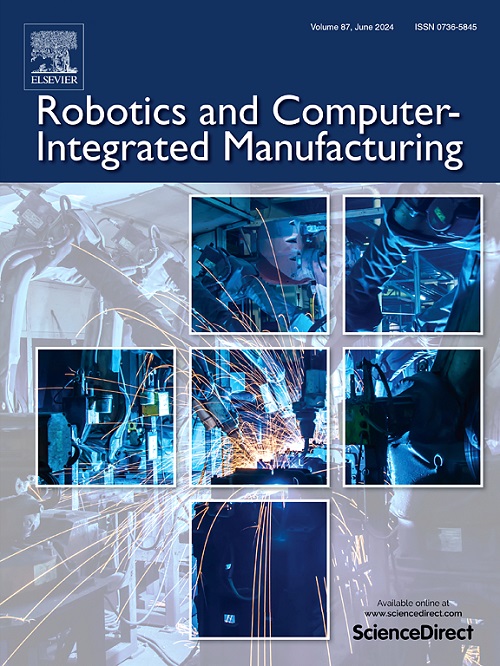内部结构柔性刀具的复杂表面机器人磨削:受限空间的多性能优化
IF 9.1
1区 计算机科学
Q1 COMPUTER SCIENCE, INTERDISCIPLINARY APPLICATIONS
引用次数: 0
摘要
机器人柔顺磨削复杂表面有限的空间是一个关键和具有挑战性的过程中生产高性能部件,如飞盘。复杂结构导致的刀具姿态轨迹变化给材料去除的接触状态带来了固有的复杂性。这反过来又会影响磨削性能和刀具寿命,以及机器人的运动学性能。建立了加工参数与材料去除过程之间的定量模型。建立了考虑机器人运动学、磨粒轨迹连续性和刀具寿命的多指标优化(MIO)模型,并采用自适应控制差分进化(ACDE)算法求解。结果表明,在不同停留时间下,预测轮廓的均方根误差(RMSE)为6.45 ~ 9.48 μm,最大停留深度为47.62 ~ 158.31 μm。同时,不同刀具姿态下三维形貌的RMSE < 12.75 μm。此外,采用MIO的刀具姿态使通道窄至23.41 cm的圆盘零件实现了平滑磨削,避免了机器人关节突变,并将加速度变化从0.81减小到0.04 rad/s3。在预定去除深度为0.3 mm时,在整个环形根表面实现均匀的材料去除,平均误差为0.013-0.016 mm。本文章由计算机程序翻译,如有差异,请以英文原文为准。
Robotic grinding of complex surfaces with an internal structured compliant tool: Multi-performance optimization in confined spaces
Robotic Compliant grinding of complex surfaces with limited space is a crucial and challenging process for the production of the high-performance components such as blisk. The trajectory-varying tool attitude, resulting from the complex structure, introduces an inherent complexity to the contact state for material removal. This, in turn, influences grinding performance and tool life, as well as robot kinematic performance. Thus, a quantitative model between the processing parameters and convoluted material removal process was established. A multi-indicator optimization (MIO) model considering robot kinematics, grit trajectory continuity and tool longevity was developed and solved by the adaptively controlled differential evolutionary (ACDE) algorithm. The results demonstrate that the root mean square error (RMSE) of the predicted contour is 6.45–9.48 μm with different dwell times featuring maximum depths from 47.62 to 158.31 μm. Meanwhile, the RMSE for the three-dimensional morphology with varying tool attitude was less than 12.75 μm. Furthermore, the tool attitudes employing MIO enabled the smoothing grinding of an blisk part featuring a channel as narrow as 23.41 cm, which avoids robot joint mutations and reduces the jerk variation from 0.81 to 0.04 rad/s3. The uniform material removal achieved over the entire annular root surface exhibited a mean error of 0.013–0.016 mm for a pre-set removal depth of 0.3 mm.
求助全文
通过发布文献求助,成功后即可免费获取论文全文。
去求助
来源期刊
CiteScore
24.10
自引率
13.50%
发文量
160
审稿时长
50 days
期刊介绍:
The journal, Robotics and Computer-Integrated Manufacturing, focuses on sharing research applications that contribute to the development of new or enhanced robotics, manufacturing technologies, and innovative manufacturing strategies that are relevant to industry. Papers that combine theory and experimental validation are preferred, while review papers on current robotics and manufacturing issues are also considered. However, papers on traditional machining processes, modeling and simulation, supply chain management, and resource optimization are generally not within the scope of the journal, as there are more appropriate journals for these topics. Similarly, papers that are overly theoretical or mathematical will be directed to other suitable journals. The journal welcomes original papers in areas such as industrial robotics, human-robot collaboration in manufacturing, cloud-based manufacturing, cyber-physical production systems, big data analytics in manufacturing, smart mechatronics, machine learning, adaptive and sustainable manufacturing, and other fields involving unique manufacturing technologies.

 求助内容:
求助内容: 应助结果提醒方式:
应助结果提醒方式:


